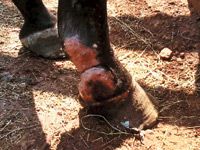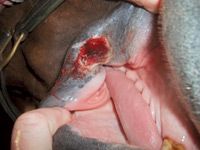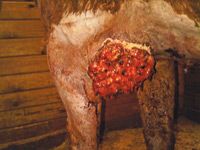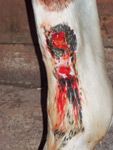The re-emergence of equine summer sores
Current weather patterns and deworming protocols are likely factors in development.
For large portions of the country, the exceptionally mild winter, early and hot spring and hotter-than-normal summer have been both a blessing and a curse for the equine population.
It was a blessing because horses did not have to endure a rough, cold winter. Early spring reduced the winter hay that needed to be fed. Adequate rain in some sections of the Southeast is helping hay production, and the consistently good weather has encouraged more riding, showing and general equine activity.
These same conditions, however, have produced overweight horses that grew fatter through the "easy" winter, only to be at risk for developing laminitis on the exceptionally lush and early spring pasture growth. Hot, moist weather after a winter with mild temperatures also vastly increased the number of flies, ticks and related equine parasites.

The long hot summer: This year's weather may have you seeing more cases of summer sores, a type of skin lesion caused by worm larvae transported by house, stable and face flies.
This year's environmental changes have contributed to problems for horse owners and their veterinarians. One of the most challenging of these issues is the re-emergence of an old problem in horses: summer sores. Recent changes in equine deworming protocols may also be contributing to an increase in this particular problem.
What are summer sores?
"Summer sores" is a horseman's term for a skin condition caused by larvae of Habronema or Draschia species worms. The adult worms of these species live on the inside wall of the equine stomach and do not migrate internally. In fact, most horses with gastric habronemiasis or Draschia species infestation do not show any clinical signs, and actual damage or impact to an adult horse is thought to be minimal. Heavy infestation in some individuals, however, has been known to cause stomach irritation and can even lead to perforation and possible stomach rupture.

Photo 1: The typical red, irritated appearance of a summer sore. Horses' lower legs are prone to all types of scrapes and cuts that can then be infected by Habronema species larvae.
The occurrence of gastric habronemiasis has been reported to vary from 2 percent to 55 percent, depending on the country and study cited, but it is thought to be common enough to keep summer sores high on a differential list for season-associated skin conditions.
The normal cycle for Habronema or Draschia species worms begins when the stomach worms' eggs are excreted in the manure and into the environment. These embryonated or developing eggs are ingested by the larvae of various types of flies. House, stable and face flies are all commonly associated with Habronema and Draschia species egg development since these flies start as larvae in manure piles. Fly larvae grow and develop, and the adult flies serve as both incubators and carriers, allowing the stomach worm eggs to develop into more advanced larval stages inside the flies that then transport them to re-enter the horse. When these infected flies land near a horse's lips, the larvae are released and swallowed by the horse, completing their life cycle.
The specific skin condition known as "summer sores" occurs when stomach worm larvae are deposited on injured or irritated skin tissue or mucous membranes (Photos 1 and 2). Moist areas of the body—such as the eyes (e.g., conjunctiva, medial canthus, nasolacrimal duct), commissure of the lips, ears, ventral abdomen, prepuce, penis and urethral process—are at risk. Areas on the limbs, especially from the fetlock to the coronary band, are frequently prone to mild cuts, scrapes and trauma and thus can also be susceptible to summer sores. Parasites (e.g., ticks, flies) also can irritate the horse, and the animal's subsequent rubbing and scratching can damage skin, allowing entry to Habronema or Draschia species larvae.

Photo 2: Moist areas of the body are sites at risk for summer sores. Habrenema species larvae were isolated from this lesion in the commisure of a horse's mouth.
This is an abnormal step in the usual life cycle for these worms and where problems begin. These "out of place" larvae cannot grow into adult worms in these locations but can induce a severe local inflammatory reaction characterized by intense swelling, ulceration, redness and itching. These lesions tend to grow rapidly and usually cause horse owners to seek veterinary advice within a few days.
Diagnosis
Summer sores, or, more correctly, cutaneous habronemiasis or Draschia species infestation, can occur in all equine species (horses, donkeys, mules and zebras) and are most prominent in parts of the world with a tropical or temperate climate. It's tough to know exactly how common this disease is because it can be difficult to definitively diagnose; many other skin infections can be similar in appearance.
Lesions associated with proud flesh, or proliferative granulation tissue, can look similar to a summer sore, and both problems tend to occur after skin trauma or injury. Various skin tumors, such as sarcoids or squamous cell carcinomas, can also look like summer sores. Also included on the differential diagnosis list would be various fungal skin infections, foreign body granulomatous reactions and pythiosis (Photo 3). In addition, larvae can be deposited in a horse's eye, and ophthalmic lesions may mimic types of ocular tumors or neoplasia, foreign bodies, phycomycosis or onchocercosis.

Photo 3: This excessively irritated granular reaction is a pythiosis lesion, but it shares many physical characteristics with a severe summer sore. Both diseases should be on a differential diagnosis list for aggressive skin lesions.
The best diagnostic methodology requires deep tissue biopsy of the lesion for histopathologic confirmation of the larvae. This is sometimes difficult because of the location of lesions and because larvae are not always easily recovered from even active lesions (Photo 4). Histopathologic examination will commonly reveal extensive ulceration and a diffuse eosinophilic infiltrate. This type of report, coupled with the case history, environmental information and elimination of other causes, usually results in a diagnosis of summer sores. In addition, molecular diagnosis is evolving, and a PCR assay is available, though it is not extensively used at this point.

Photo 4: This lower leg lesion began as a simple scrape and rapidly became more reactive and irritated. Deep biopsies of this site failed to reveal Habronema species larvae, but treatment with ivermectin, anti-inflammatories and corticosteroids resulted in resolution of the skin reaction.
Treatment and prevention
Treatment usually includes larvicidal, anti-inflammatory and antimicrobial components. Ivermectin has commonly been used to kill both the adult worms in the stomach and the larval forms in the skin tissue. A single dose of ivermectin is generally sufficient to kill Habronema species larvae. But some horses don't respond or they become reinfected, necessitating multiple doses.
Corticosteroids reduce the inflammatory hypersensitivity reaction, and antimicrobials treat secondary infections, usually a result of self-inflicted biting, rubbing and itching. Refractory lesions may require extensive surgical débridement to adequately remove degenerative larvae within the tissue.
In terms of prevention, fly control, manure removal and the quick and appropriate treatment of skin wounds and infections can greatly reduce the incidence and severity of summer sores.
Deworming practices as a contributing factor
A major shift in the methods of equine parasite control has been underway during the past few years. Ray Kaplan, DVM, PhD, a parasitologist at the University of Georgia's College of Veterinary Medicine, along with other parasitologists and researchers, published a study in 2004 that looked at the prevalence and resistance of various equine parasites.1 Kaplan and Martin Nielsen, DVM, PhD, then at the Department of Large Animal Sciences at the University of Copenhagen, followed with an evidence-based approach to deworming horses that essentially recommended increased fecal testing and decreased use of anthelmintics based on that testing.2 Most equine veterinarians and horse owners have adopted some form of this program during the past few years. It's interesting to note that we are now seeing the results of this selective therapy deworming, and certain problems, such as an increase in summer sores, may be one of them.
When horses were dewormed every eight weeks, which was the previously recommended schedule, horses were never without anthelmintics in their systems for very long, and deworming products commonly overlapped in coverage. Currently, horses that have low to nonexistent parasite egg counts via fecal testing may go for extended periods (four months or longer) without a dose of dewormer. Certain parasites have a higher chance of causing problems during these low-treatment periods. In the hot southern climates, these low-treatment periods correspond to the summer months, and ticks and fly larvae may be developing an advantage.
Nielsen, currently at the University of Kentucky's Gluck Center, also acknowledges that certain parasites (e.g., Strongylus vulgaris) may be circumventing the selective therapy deworming programs and staging a comeback. In an article soon to be published in Veterinary Parasitology, Nielsen looked at the prevalence of S. vulgaris at a number of horse farms in Denmark. He compared farms using selective treatment (based on regular fecal egg counts from all horses) with farms that treated strategically (i.e., without egg counts). Farms using selective therapy had a horse and farm prevalence of more than twice that of farms not using that approach. Nielsen concludes that "a strict interpretation of the selective therapy regimen can be associated with an increased prevalence of S. vulgaris."
Both Kaplan and Nielsen suggest that modifications of their equine parasite-control program could be considered. Kaplan explains, "The overriding important concept is that there is no one 'correct' parasite-control program. What's best for one farm won't be the same for another. But we do know that the traditional [every eight weeks] approach is a very poor strategy for controlling cyathostomes and often will fail to provide optimal control.
"However, there are side effects to this approach, such as the near eradication of some species of parasites," Kaplan continues. "What we're doing now is taking what evidence we have to make sensible recommendations, but these will continue to evolve as we learn more."
Additional use of ivermectin and moxidectin during the hot summer months to provide protection from ticks and fly larvae and to keep summer sores from increasing may be one of the first modifications that practitioners should consider.
Dr. Kenneth Marcella is an equine practitioner in Canton, Ga.
References
1. Kaplan RM, Klei TR, Lyons ET, et al. Prevalence of anthelmintic resistant cyathostomes on horse farms. J Am Vet Med Assoc 2004;225(6):903-910.
2. Kaplan RM, Nielsen MK. An evidence-based approach to equine parasite control: it ain't the 60s anymore. Equine Vet Educ 2010;22(6):306-316.
Newsletter
From exam room tips to practice management insights, get trusted veterinary news delivered straight to your inbox—subscribe to dvm360.